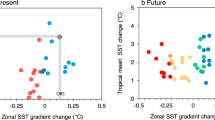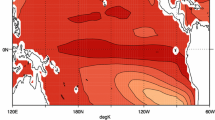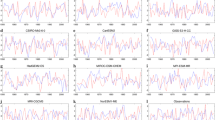Abstract
Precipitation changes over the Indo-Pacific during El Niño events are studied using an Atmospheric General Circulation Model forced with sea-surface temperature (SST) anomalies and changes in atmospheric CO2 concentrations. Linear increases in the amplitude of the El Niño SST anomaly pattern trigger nonlinear changes in precipitation amounts, resulting in shifts in the location and orientation of the Intertropical Convergence Zone (ITCZ) and the South Pacific Convergence Zone (SPCZ). In particular, the maximum precipitation anomaly along the ITCZ and SPCZ shifts eastwards, the ITCZ shifts south towards the equator, and the SPCZ becomes more zonal. Precipitation in the equatorial Pacific also increases nonlinearly. The effect of increasing CO2 levels and warming SSTs is also investigated. Global warming generally enhances the tropical Pacific precipitation response to El Niño. The precipitation response to El Niño is found to be dominated by changes in the atmospheric mean circulation dynamics, whereas the response to global warming is a balance between dynamic and thermodynamic changes. While the dependence of projected climate change impacts on seasonal variability is well-established, this study reveals that the impact of global warming on Pacific precipitation also depends strongly on the magnitude of the El Niño event. The magnitude and structure of the precipitation changes are also sensitive to the spatial structure of the global warming SST pattern.











Similar content being viewed by others
Notes
References
Adler RF, Huffman GJ, Chang A, Ferraro R, Xie P, Janowiak J, Rudolf B, Schneider U, Curtis S, Bolvin D, Gruber A, Susskind J, Arkin P, Nelkin E (2003) The Version 2 Global Precipitation Climatology Project (GPCP) monthly precipitation analysis (1979–present). J Hydrometeorol 4:1147–1167
Australian Bureau of Meteorology and CSIRO (2011) Climate change in the Pacific: scientific assessment and new research. Volume 1: regional overview. Volume 2: Country Reports
Bi D, Dix M, Marsland S, OFarrell S, Rashid HA, Uotila P, Hirst T, Kowalczyk E, Golebiewski M, Sullivan A, Yan H, Hanna N, Franklin C, Sun Z, Vohralik P, Watterson I, Zhou X, Fiedler R, Collier M, Ma Y, Noonan J, Stevens L, Uhe P, Zhu H, Hill R, Harris C, Griffies S, Puri K (2012) The ACCESS coupled model: description, control climate and preliminary validation. Aust Meteorol Oceanogr J, submitted
Bradley R, Diaz HF, en Eischeid JK (1987) ENSO signal in continental precipitation records. Nature 327:497–501
Brown JR, Power SB, Delage FP, Colman RA, Moise AF, Murphy BF (2011) Evaluation of the South Pacific Convergence Zone in IPCC AR4 climate model simulations of the twentieth century. J Clim 24:1565–1582
Brown JR, Moise A, Delage F (2012a) Changes in the South Pacific Convergence Zone in IPCC AR4 future climate projections. Clim Dyn 39:1–19. doi:10.1007/s00382-011-1192-0
Brown JR, Moise A, Colman RA (2012b) The South Pacific Convergence Zone in CMIP5 simulations of historical and future climate. Clim Dyn. doi:10.1007/s00382-012-1591-x
Cai W, van Rensch P, Cowan T, Sullivan A (2010) Asymmetry in ENSO teleconnection with regional rainfall, its multidecadal variability, and impact. J Clim 23:4944–4955
Cai W, Lengaigne M, Borlace S, Collins M, Cowan T, McPhaden M, A T, Power S, Brown J, Menkes C, Ngari A, Vincent E, Widlansky M (2012) More extreme swings of the South Pacific Convergence Zone due to greenhouse warming. Nature 488:365–369
Chiang JC, Kushnir Y, Zebiak SE (2000) Interdecadal changes in eastern Pacific ITCZ variability and its influence on the Atlantic ITCZ. Geo Res Lett 27:3687–3690
Collins M, An SI, Cai W, Ganachaud A, Guilyardi E, Jin FF, Jochum M, Lengaigne M, Power S, Timmermann A, Vecchi G, Wittenberg A (2010) The impact of global warming on the Tropical Pacific Ocean and El Niño. Nat Geosci 3:391–397
Cusack S, Edwards JM, Crowther JM (1999) Investigating k distribution methods for parameterizing gaseous absorption in the Hadley Centre Climate Model. J Geogr Res 104(D2):2051–2057
Davies T, Cullen MJP, Malcolm AJ, Mawson MH, Staniforth A, White AA, Wood N (2005) A new dynamical core for the Met Office’s global and regional modelling of the atmosphere. Q J R Meteorol Soc 131(608):1759–1782. doi:10.1256/qj.04.101
Edwards JM, Slingo A (1996) Studies with a flexible new radiation code. I: choosing a configuration for a large-scale model. Q J R Meteorol Soc 122(531):689–719. doi:10.1002/qj.49712253107
Emori S, Brown SJ (2005) Dynamic and thermodynamic changes in mean and extreme precipitation under changed climate. Geophys Res Lett 32:L17706. doi:10.1029/2005GL023272
Essery R, Best M, Cox P (2001) MOSES 2.2 technical documentation. Hadley Centre Technical Note 30, Met Office, Exeter, United Kingdom. http://www.metoffice.gov.uk/research/hadleycentre/pubs/HCTN/index.html
Fritsch J, Chappell C (1980) Numerical prediction of convectively driven mesoscale pressure systems. Part I: convective parameterization. J Atmos Sci 37:1722–1733
Folland CK, Renwick JA, Salinger MJ, Mullan AB (2013) Relative influences of the Interdecadal Pacific Oscillation and ENSO on the South Pacific Convergence Zone. Geophys Res Lett 29(13). doi:10.1029/2001GL014201
Gregory D, Rowntree PR (1990) A mass flux convection scheme with representation of cloud ensemble characteristics and stability-dependent closure. Mon Weather Rev 118:1483–1506
Gregory D, Inness P, Gregory J (1999) Convection Scheme. In: Unified Model Documentation Paper 27, Met Office, Exeter, United Kingdom
Hoerling MP, Kumar A, Zhong M (1997) El Niño, La Niña, and the nonlinearity of their teleconnections. J Clim 10:1769–1786
Hoerling MP, Kumar A, Xu TY (2001) Robustness of the nonlinear climate response to ENSO’s extreme phases. J Clim 14:1277–1293
Huffman GJ, Adler RF, Bolvin DT, Gu G (2009) Improving the global precipitation record: GPCP version 2.1. Geophys Res Lett 36:L17,808. doi:10.1029/2009GL040000
Hurrell JW, Hack JH, Shea D, M CJ, Rosinski J (2008) A new sea surface temperature and sea ice boundary dataset for the community atmosphere model. J Clim 21:5145–5153. doi:10.1175/2008JCLI2292.1
Knutti R, Sedláček J (2012) Robustness and uncertainties in the new CMIP5 climate model projections. Nat Clim Change 3:369–373
Kug JS, Jin FF, An SI (2009) Two types of El Niño events: cold tongue El Niño and warm pool El Niño. J Clim 22:1499–1515
Lau KM, Boyle JS (1987) Tropical and extratropical forcing of the large-scale circulation: a diagnostic study. Mon Weather Rev 115:400–28
Lengaigne M, Vecchi GA (2009) Contrasting the termination of moderate and extreme El Niño events in coupled general circulation models. Clim Dyn. doi:10.1007/s00382-009-0562-3
Lock AP, Brown AR, Bush MR, Martin GM, Smith RNB (2000) A new boundary layer mixing scheme. Part I: scheme description and single-column model tests. Mon Weather Rev 128:3187–3199
Martin GM, Ringer MA, Pope VD, Jones A, Dearden C, Hinton TJ (2006) The physical properties of the atmosphere in the New Hadley Centre Global Environmental Model (HadGEM1). Part I: model description and global climatology. J Clim 19:1274–1301
Martin GM, Milton SF, Senior CA, Brooks ME, Ineson S (2010) Analysis and reduction of systematic errors through a seamless approach to modeling weather and climate. J Clim 23:5933–5957
Martin GM, Bellouin N, Collins WJ, Culverwell ID, Halloran PR, Hardiman SC, Hinton TJ, Jones CD, McDonald RE, McLaren AJ, O’Connor FM, Roberts MJ, Rodriguez JM, Woodward S, Best MJ, Brooks ME, Brown AR, Butchart N, Dearden C, Derbyshire SH, Dharssi I, Doutriaux-Boucher M, Edwards JM, Falloon PD, Gedney N, Gray LJ, Hewitt HT, Hobson M, Huddleston MR, Hughes J, Ineson S, Ingram WJ, James PM, Johns TC, Johnson CE, Jones A, Jones CP, Joshi MM, Keen AB, Liddicoat S, Lock AP, Maidens AV, Manners JC, Milton SF, Rae JGL, Ridley JK, Sellar A, Senior CA, Totterdell IJ, Verhoef A, Vidale PL, Wiltshire A (2011) The HadGEM2 family of Met Office Unified Model Climate configurations. Geosci Model Dev Discuss 4(2):765–841. doi:10.5194/gmdd-4-765-2011
McGregor S, Timmermann A, Schneider N (2012) The effect of the South Pacific Convergence Zone on the termination of El Nio events and the meridional asymmetry of ENSO. J Clim 25:5566–5586
McGregor S, Ramesh N, Spence P, England MH, McPhaden MJ, Santoso A (2013) Meridional movement of wind anomalies during ENSO events and their role in event termination. Geophys Res Lett 40:749–754
McPhaden MJ, Lee T, McClurg D (2011) El Niño and its relationship to changing background conditions in the Tropical Pacific. Geophys Res Lett 38:15709. doi:10.1029/2011GL048275
Meehl G, TF Stocker W, Collins P, Friedlingstein A, Gaye J, Gregory A, Kitoh R, Knutti J, Murphy A, Noda S, Raper I, Watterson A, Weaver, Zhao ZC (2007) Global climate projections. In: Climate change 2007: the physical science basis. Contribution of Working Group I to the Fourth Assessment Report of the Intergovernmental Panel on Climate Change. Cambridge University Press, Cambridge, United Kingdom and New York, NY, USA
Meehl GA (1987) The annual cycle and interannual variability in the Tropical Pacific and Indian Ocean Regions. Mon Weather Rev 115:27–50. doi:10.1175/1520-0493(1987)115<0027:TACAIV>2.0.CO;2
Monahan AH, Dai A (2004) The spatial and temporal structure of ENSO nonlinearity. J Clim 17(15):3026–3036. doi:10.1175/1520-0442(2004)017%3C3026:TSATSO%3E2.0.CO;2
Mullan AB (1996) Non-linear effects of the southern oscillation in the New Zealand region. Aust Meteorol Mag 45:83–99
Münnich M, Neelin JD (2005) Seasonal influence of ENSO on the Atlantic ITCZ and equatorial South America. Geophys Res Lett 32:L21,709
Newman M, Shin SI, Alexander MA (2011) Natural variation in ENSO flavors. Geophys Res Lett L14705. doi:10.1029/2011GL047658
Ohba M, Ueda H (2009) Role of nonlinear atmospheric response to SST on the asymmetric transition process of ENSO. J Clim 22:177–192
Okumura YM, Deser C (2010) Asymmetry in the duration of El Niño and La Niña. J Clim 23:5826–5843
Philander S (1990) El Niño, La Niña, and the Southern Oscillation. Academic Press, New York
Power S, Smith IN (2007) Weakening of the Walker Circulation and apparent dominance of El Niño both reach record levels, but has ENSO really changed? Geophys Res Lett 34:L18,702,4
Power S, Haylock M, Colman R, Wang X (2006) The predictability of interdecadal changes in ENSO and ENSO teleconnections. J Clim 19:4755–4771
Ropelewski CF, Halpert MS (1989) Precipitation patterns associated with the high index phase of the Southern Oscillation. J Clim 2:268–284. doi:10.1175/1520-0442(1989)002<0268:PPAWTH>2.0.CO;2
Seager R, Naik N, Vecchi GA (2010) Thermodynamic and dynamic mechanisms for large-scale changes in the hydrological cycle in response to global warming. J Clim 23:4651–4668. doi:10.1175/2010JCLI3655.1
Seager R, Naik N, Vogel L (2012) Does global warming cause intensified interannual hydroclimate variability? J Clim 25:3355–3372. doi:10.1175/JCLI-D-11-00363.1
Smith RNB (1990) A scheme for predicting layer clouds and their water content in a general circulation model. Q J R Meteorol Soc 116:435–460
Smith RNB (1993) Experience and developments with the layer cloud and boundary layer mixing schemes in the UK Meteorological Office Unified Model. In: Proceedings of ECMWF/GCSS workshop on parametrization of the cloud-topped boundary layer, ECMWF, Reading, England, pp 319–339
Staniforth A, White A, Wood N (2003) Analysis of semi-Lagrangian trajectory computations. Q J R Meteorol Soc 129(591):2065–2085. doi:10.1256/qj.02.115
Streten NA (1973) Some characteristics of satellite-observed bands of persistent cloudiness over the Southern Hemisphere. Mon Weather Rev 101:486–495. doi:10.1175/1520-0493(1973)101<0486:SCOSBO>2.3.CO;2
Trenberth KE (1976) Spatial and temporal variations of the Southern Oscillation. Q J R Meteorol Soc 102(433):639–653. doi:10.1002/qj.49710243310, http://dx.doi.org/10.1002/qj.49710243310
Vecchi GA, Wittenberg AT (2010) El Niño and our future climate: where do we stand? Wiley Interdiscip Rev Clim Change 1:260–270
Vincent DG (1994) The South Pacific Convergence Zone (SPCZ): a review. Mon Weather Rev 122:1949–1970
Vincent E, Lengaigne M, Menkes C, Jourdain N, Marchesiello P, Madec G (2011) Interannual variability of the South Pacific Convergence Zone and implications for tropical cyclone genesis. Clim Dyn 36:1881–1896. doi:10.1007/s00382-009-0716-3
Waliser DE, Gautier C (1993) A satellite-derived climatology of the ITCZ. J Clim 6:2162–2174
Widlansky MJ, Webster PJ, Hoyos CD (2011) On the location and orientation of the South Pacific convergence zone. Clim Dyn 36:561–578
Widlansky MJ, Timmermann A, Stein K, McGregor S, Schneider N, England MH, Lengaigne M, Cai W (2013) Changes in South Pacific rainfall bands in a warming climate. Nat Clim Change 3:417–423
Wilson DR, Ballard SP (1999) A microphysically based precipitation scheme for the UK meteorological office unified model. Q J R Meteorol Soc 125(557):1607–1636. doi:10.1002/qj.49712555707
Wu B, Li T, Zhou T (2010) Asymmetry of atmospheric circulation anomalies over the western North Pacific between El Niño and La Niña. J Clim 23:4807–4822
Xie SP, Deser C, Vecchi GA, Ma J, Teng H, Wittenberg AT (2010) Global warming pattern formation: sea surface temperature and rainfall. J Clim 23:966–986
Yeh SW, Kug JS, Dewitte B, Kwon MH, Kirtman BP, Jin FF (2009) El Niño in a changing climate. Nature 461:511–514
Acknowledgments
This work was supported by the Pacific-Australia Climate Change Science and Adaptation Planning Program (PACC–SAP), a program supported by AusAID in collaboration with the Department of Climate Change and Energy Efficiency and delivered by the Bureau of Meteorology and the Commonwealth Scientific and Industrial Research Organisation (CSIRO). We would like to thank the anonymous referees, Josephine Brown, Dietmar Dommenget, and Brad Murphy for very helpful comments on the manuscript. We would also like to thank Malek Ghantous for help in configuring the ACCESS model, Greg Kociuba for additional CMIP3 data analysis, François Delage for providing useful data visualisation routines, and Aurel Moise for useful discussions. We acknowledge the modeling groups, the Program for Climate Model Diagnosis and Intercomparison (PCMDI) and the WCRP’s Working Group on Coupled Modelling (WGCM) for their roles in making available the WCRP CMIP3 multi-model dataset. Support of this dataset is provided by the Office of Science, U.S. Department of Energy.
Author information
Authors and Affiliations
Corresponding author
Rights and permissions
About this article
Cite this article
Chung, C.T.Y., Power, S.B., Arblaster, J.M. et al. Nonlinear precipitation response to El Niño and global warming in the Indo-Pacific. Clim Dyn 42, 1837–1856 (2014). https://doi.org/10.1007/s00382-013-1892-8
Received:
Accepted:
Published:
Issue Date:
DOI: https://doi.org/10.1007/s00382-013-1892-8




